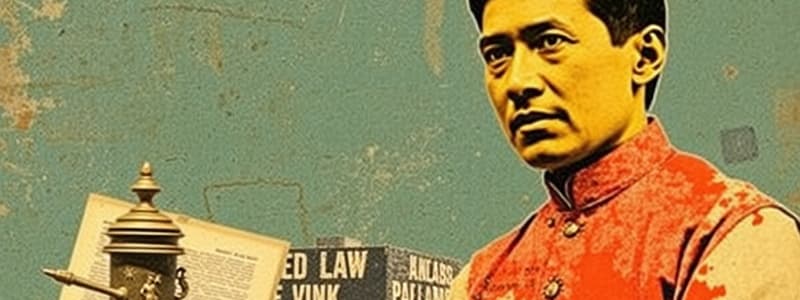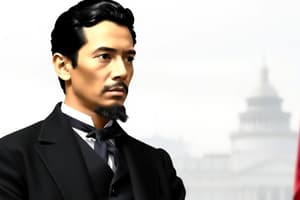Podcast
Questions and Answers
Which of the following accurately describes the original intention behind the creation of Republic Act 1425, also known as the Rizal Law?
Which of the following accurately describes the original intention behind the creation of Republic Act 1425, also known as the Rizal Law?
- To provide a comprehensive comparison between Rizal's novels and contemporary literary works.
- To offer an alternative subject focusing on national heroes other than Rizal.
- To require all colleges and universities in the Philippines to include Rizal's life, works, Noli Me Tangere and El Filibusterismo in their curriculum. (correct)
- To mandate the study of Rizal's life and works exclusively in private universities.
What was the primary objective of Senator Claro M. Recto in proposing Senate Bill No. 438?
What was the primary objective of Senator Claro M. Recto in proposing Senate Bill No. 438?
- To allocate additional funding for research on Jose Rizal's family history and ancestry.
- To translate Rizal's works into various Filipino dialects to broaden their accessibility.
- To promote the study of Philippine history, with an emphasis on the Spanish colonial period.
- To make the reading of Noli Me Tangere and El Filibusterismo a mandatory part of the curriculum in all public and private colleges and universities to instill nationalism. (correct)
What was the significance of June 12, 1956, in relation to the Rizal Law?
What was the significance of June 12, 1956, in relation to the Rizal Law?
- It was the day President Ramon Magsaysay signed the bill into law, officially making it Republic Act 1425. (correct)
- It was when the first translations of Rizal's novels into English became widely available.
- It marked the start of classroom discussions and debates concerning the controversial themes of the Noli Me Tangere.
- It was the day when the Catholic Church formally withdrew its opposition to the Rizal bill.
Which of the following was NOT a stated goal of the Rizal Law?
Which of the following was NOT a stated goal of the Rizal Law?
Considering the context surrounding the implementation of the Claveria Decree, what was its ultimate effect on Filipino families?
Considering the context surrounding the implementation of the Claveria Decree, what was its ultimate effect on Filipino families?
How did the nickname 'Pepe' originate in relation to Jose Rizal?
How did the nickname 'Pepe' originate in relation to Jose Rizal?
What was the significance of Rizal learning to read and write before the age of 5?
What was the significance of Rizal learning to read and write before the age of 5?
In what way did Tiyo Gregorio influence the intellectual development of Rizal?
In what way did Tiyo Gregorio influence the intellectual development of Rizal?
What was the role of Tiyo Manuel in Rizal's upbringing and development?
What was the role of Tiyo Manuel in Rizal's upbringing and development?
What role did Paciano play in Jose Rizal's early life, particularly during Rizal's time in Binan?
What role did Paciano play in Jose Rizal's early life, particularly during Rizal's time in Binan?
Flashcards
What is Rizal Law (RA 1425)?
What is Rizal Law (RA 1425)?
A law mandating all colleges/universities in the Philippines to teach Rizal's life, works (Noli Me Tangere, El Filibusterismo).
Who is Claro M. Recto?
Who is Claro M. Recto?
Senator who submitted the bill to the Senate Commitee of Education to make Noli Me Tangere and El Filibusterismo compulsory reading.
Who is Jose P. Laurel?
Who is Jose P. Laurel?
Senator and head of the Senate Committee who sponsored and presented the Noli-Fili bill
What are the goals of Rizal Law?
What are the goals of Rizal Law?
Signup and view all the flashcards
When and where was José Rizal born?
When and where was José Rizal born?
Signup and view all the flashcards
Who baptized Rizal?
Who baptized Rizal?
Signup and view all the flashcards
What is the origin of Mercado?
What is the origin of Mercado?
Signup and view all the flashcards
What is the origin of Rizal?
What is the origin of Rizal?
Signup and view all the flashcards
What does 'Ricial' mean?
What does 'Ricial' mean?
Signup and view all the flashcards
Who was Rizal's first teacher?
Who was Rizal's first teacher?
Signup and view all the flashcards
Study Notes
- Rizal Law or RA 1425 mandates all colleges/universities in the Philippines to teach Rizal's life and works, including "Noli Me Tangere" and "El Filibusterismo".
- April 3, 1956: Senator Claro M. Recto submitted Senate Bill No. 438, known as "An Act to Make Noli Me Tangere and El Filibusterismo Compulsory Reading Matter."
- April 17, 1956: Senator Jose P. Laurel, head of the Senate Committee, sponsored and presented the Noli-Fili bill in Upper House.
- The Catholic Church opposed the Noli-Fili bill.
- April 19, 1956: House Bill No. 5561 was also filed in the House of Representatives, led by Congressman Jacobo Z. Gonzales.
- Despite opposition, Senate Bill No. 438 and House Bill No. 5561 were approved on the second reading in the Lower House on May 12 and 14, 1956.
- June 12, 1956, Flag Day: President Ramon Magsaysay signed Republic Act 1425, also known as the Rizal Law.
Goals of Rizal Law
- Rededicates the lives of youth to ideals of freedom and nationalism.
- Pays tribute to the national hero.
- Gains an inspiring source of patriotism through the study of Rizal's life, works, and writings.
Jose Protacio Rizal Mercado y Alonso Realonda
- Born on June 19, 1861, in Calamba, Laguna.
- The birth occurred between 11 pm and 12 am.
- Rizal's mother almost died due to his large head.
- June 22, 1861: Rizal was baptized.
- Father Rufino Collantes baptized him.
- Named Jose after his mother's devotion to Saint Joseph.
- Protacio came from St. Gervacio Protacio.
- Mercado came from his Chinese ancestor Domingo Lam-co, and means "market."
- Rizal was adopted by the Mercados in the 1840s due to the Claveria decree.
- In the 1840s, Governor-General Narciso Claveria issued a decree for Filipinos to have surnames for census data and tax collection.
- Surnames came from the "Catalogo alfabetico de apellidos" ("Alphabetical Catalogue of Surnames in English").
- "Ricial" means "the green of young growth" or "green fields", connected to their livelihood.
- Nickname: Pepe.
- Other nickname: Wonderchild.
- His sisters would make fun of little pepe because he was short for his age, and he had a big head that was not propotional to his body.
- According to "In Excelsis," "P.P." was placed after Saint San Jose's name standing for pater putativus, meaning putitative father, or legal father of Jesus Christ..
- Learned how to read and write before age 5.
- His mother was his first teacher.
- Fav story: the story of the moth.
- Rizal had a male black dog named Usman Braganza.
- Pony Horse: Alipato.
- When pepe was a little boy, he would often hangout by himself in the bahay kubo in their yard.
- Sisters found him molding clay into a statue of Napoleon Bonafarte.
- He was sent by his mother's hometown of biñan to study under Justiniano Aquino Cruz.
- Father of Rizal: Francisco Engracio Rizal Mercado y Alejandro.
- Mother of Rizal: Teodora Alonso Realonda y Quintos.
- Eleven siblings: Saturnina, Paciano, Narcisa, Olimpia, Lucia, Maria, Jose Rizal, Concepcion, Josefa, Trinidad, Soledad.
Influence of Family
- Tiyo Jose nurtured Rizal's appreciation for nature and taught him painting, drawing, and sculpture.
- Tiyo Gregorio instilled a love for education and emphasized hard work, encouraging critical thinking and observation.
- Tiyo Manuel worried about Rizal's physical development and taught him swimming, fencing, wrestling, and martial arts.
- Leon Monroy, who lived with the family, taught Rizal Spanish and Latin.
- Paciano served as a father figure while Rizal studied in Biñan.
- First Sorrow: Concepcion.
- Private tutors: Maestro Celestino and Maestro Lucas Padua.
Studying That Suits You
Use AI to generate personalized quizzes and flashcards to suit your learning preferences.




